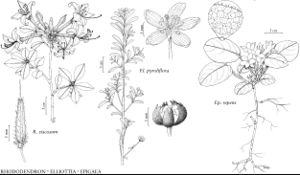Difference between revisions of "Epigaea"
Sp. Pl. 1: 395. 1753.
Gen. Pl. ed. 5, 186. 1754 ,.
FNA>Volume Importer |
imported>Volume Importer |
||
| (6 intermediate revisions by 2 users not shown) | |||
| Line 6: | Line 6: | ||
|place=1: 395. 1753 | |place=1: 395. 1753 | ||
|year=1753 | |year=1753 | ||
| − | }}{{Treatment/Publication | + | }}, {{Treatment/Publication |
|title=Gen. Pl. ed. | |title=Gen. Pl. ed. | ||
|place=5, 186. 1754 , | |place=5, 186. 1754 , | ||
| Line 27: | Line 27: | ||
|discussion=<p>Orphanidesia Boissier & Balansa</p><!-- | |discussion=<p>Orphanidesia Boissier & Balansa</p><!-- | ||
--><p>Species 3 (1 in the flora).</p><!-- | --><p>Species 3 (1 in the flora).</p><!-- | ||
| − | --><p>Epigaea comprises E. repens in eastern North America, E. asiatica Maximowicz in eastern Asia, and E. gaultherioides (Boissier & Balansa) Takhtajan in southwestern Asia (Caucasus region).</p><!-- | + | --><p><i>Epigaea</i> comprises <i>E. repens</i> in eastern North America, E. asiatica Maximowicz in eastern Asia, and E. gaultherioides (Boissier & Balansa) Takhtajan in southwestern Asia (Caucasus region).</p><!-- |
| − | --><p>The species of Epigaea are infrequently cultivated; they are difficult to establish and maintain (M. A. Dirr 1998).</p> | + | --><p>The species of <i>Epigaea</i> are infrequently cultivated; they are difficult to establish and maintain (M. A. Dirr 1998).</p> |
|tables= | |tables= | ||
|references={{Treatment/Reference | |references={{Treatment/Reference | ||
| Line 58: | Line 58: | ||
|publication year=1753; | |publication year=1753; | ||
|special status= | |special status= | ||
| − | |source xml=https:// | + | |source xml=https://bitbucket.org/aafc-mbb/fna-data-curation/src/2e0870ddd59836b60bcf96646a41e87ea5a5943a/coarse_grained_fna_xml/V8/V8_927.xml |
|subfamily=Ericaceae subfam. Ericoideae | |subfamily=Ericaceae subfam. Ericoideae | ||
|genus=Epigaea | |genus=Epigaea | ||
Latest revision as of 22:47, 5 November 2020
Subshrubs. Stems creeping or prostrate; twigs coarsely hirsute (especially new growth). Leaves persistent, alternate; petiole present; blade coriaceous, margins entire. Inflorescences axillary or terminal, spikes or dense racemes, 2–6(–10)-flowered; perulae absent. Flowers bisexual or unisexual (functionally dioecious), radially symmetric; sepals 5, distinct, (imbricate); petals 5, connate for ca. 1/2 their lengths, corolla ± deciduous, ± salverform; stamens 10, included; anthers without awns, dehiscent by longitudinal slits; ovary 5-locular; style included; stigma 5-lobed. Fruits capsular, depressed-globose, dehiscence septicidal. Seeds ca. 100, ovoid to globose, not winged, not tailed; testa foveolate. x = 12.
Distribution
North America, e, sw Asia.
Discussion
Orphanidesia Boissier & Balansa
Species 3 (1 in the flora).
Epigaea comprises E. repens in eastern North America, E. asiatica Maximowicz in eastern Asia, and E. gaultherioides (Boissier & Balansa) Takhtajan in southwestern Asia (Caucasus region).
The species of Epigaea are infrequently cultivated; they are difficult to establish and maintain (M. A. Dirr 1998).
